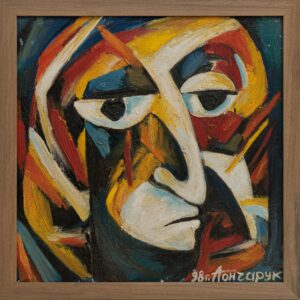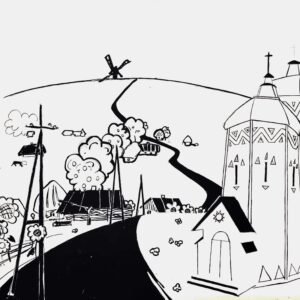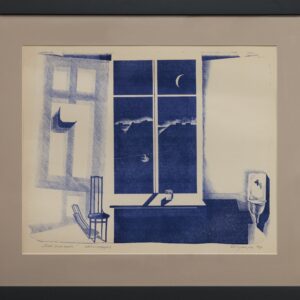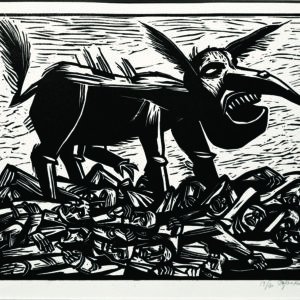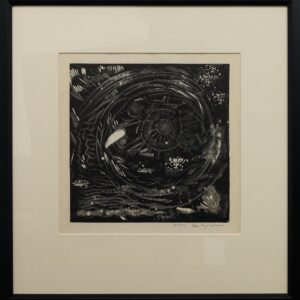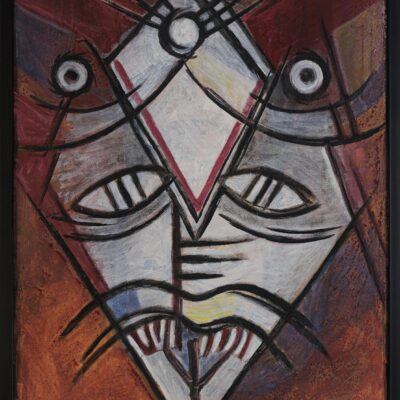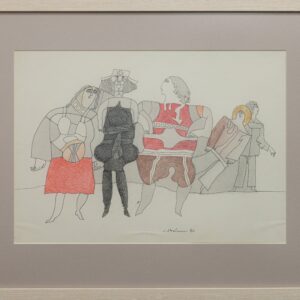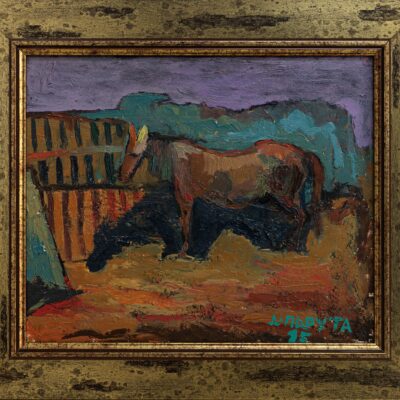Showing 1–40 of 91 results
Filters-
Ада Рибачук Гравюра зі серії «Хіросіма»
Starting bid 1200$Ada Rybachuk (1931-2010) was a Ukrainian artist and author of monumental and architectural works. She worked in creative tandem with her husband, Volodymyr Melnychenko. Her artistic approach gravitated toward modernism with elements of expressionism and symbolism. One of the key directions of her work was the creation of a visual language capable of conveying ideas and emotions that resonate with global human issues: war, memory, the fragility of human life, and the struggle for freedom. She participated in numerous Ukrainian and international exhibitions.
The engraving from the "Hiroshima" series is the artist's statement on the nuclear bombing of Japanese cities during World War II, her attempt to comprehend this tragedy. The linear structure and fine detailing of the engraving create a sense of fractured space, reflecting inner pain and chaos. Rough forms, the dynamism of lines, and the fragmentation of composition convey the tension and horror of the bomb’s destructive force. Ada Rybachuk not only documented a historical event but also urged the viewer to reflect on the cost of progress and humanity's responsibility in using technology. This engraving carries a strong emotional and historical message.
-
Алла Гончарук «Жінка з Карпат», 1979
Starting bid 1000$Alla Honcharuk (1947) is a Ukrainian artist who works in an expressive painting style. In the 1970s, she fundamentally disregarded the rules of the Soviet situation to reveal the themes of humanism, faith, hope, and honesty. In all her plots, Alla Honcharuk brings up the problem of humans in society, cityscapes, still lifes, genre scenes, and symbolic compositions. Among her stylistic references are post-impressionism, ancient icon painting, German expressionism, and the work of the Armenian artist Minas Avetisyan. Her manner is characterized by a limited palette of primary colors: red, blue, yellow, and black. Due to contrasts and rich colors, the artist is included in the "strict style" - the direction of realistic Soviet painting of the 1960s. Her works have been exhibited at Ukrainian and international exhibitions since 1978. Currently, her works are stored in the Lviv Art Gallery, the National Museum in Lviv named after A. Sheptytsky, and the Khmelnytskyi Art Museum.
The artist created the work "Woman from the Carpathians" under the impression of student ethnographic practice in the Carpathians in the summer of 1973: the large-scale symbolism of the mountains, the authenticity of the Hutsul culture faded under the needs of the urbanized world, folk craftsmen lost their deep connection with the sources of ancient crafts. The woman in the picture conveys the feeling of being unable to fit into someone else's imposed social structure. Her feet are rooted in her native land, but she stands uncertainly, looking obliquely into the distance at the city where she descends. Behind her, the mountains are burning red - in her past are the strength and stubbornness of the original Hutsul spirit. In front of her is a valley flooded with black - her present is drowning in the hustle and bustle of the city, new complex relationships between people.
-
Алла Гончарук «Пісня-1»
Starting bid 400$Alla Honcharuk (1946) is a Ukrainian artist and an outsider of Lviv’s art scene in the 1980s–1990s. She works in a unique eclectic style and expressive painting manner. In the 1970s, she rejected the canons of Soviet art, focusing on formal experiments in global avant-garde and expressive depictions of reality. In her urban landscapes, still lifes, genre scenes, and symbolic compositions, she explores the interaction between a solitary individual and society. Her style is influenced by German Expressionism and features a limited palette of primary colors: red, blue, yellow, and black.
Song-1 is one of the compositions exploring folkloric characters the artist encountered in the Carpathians. The broken depiction of facial expressions resembles the experiments of Parisian Cubists. The composition creates an effect of movement and vibration, as if transforming sound into a visual image. Filled with emotional energy, the painting immerses the viewer in the pure rhythm of a Carpathian melody.
The late 1990s became a period of refined polishing of Honcharuk’s distinctive style, where imagery is intertwined with the transmission of linear rhythm, impulse, and resonance through color. This work captivates with its ability to convey the energy of music through painting.
-
Alla Horska "Picturesque Ukraine. Church in the village", 1960s
Starting bid 2000$Alla Horska (1929 - 1970) is a Ukrainian artist, social activist, and one of the founders of the Shistdesiatnyky (The Sixtiers) movement. She worked in monumental and easel art, graphics, and scenography. Plastic generalization, movement potential and local flavour are characteristic of Horska's art style. Along with Opanas Zalyvakha, Borys Plaksii and Halyna Sevruk, the artist is considered one of the founders of a new monumental style, which is based on the ancient Ukrainian monumental tradition and uses the experience of notable phenomena of monumental modernism in the world. Among the iconic works are the stained-glass Shevchenko window (co-authored), mosaic compositions in Donetsk, Mariupol and Krasnodon, and stylized portraits of Ukrainian artists, particularly those of the sixties. The works are imbued with deep symbolism and neo-futuristic aesthetics, emphasized by red, black and white colours. The artist's works are stored in the leading museums of Ukraine, the Museum of the Berlin Wall "Checkpoint-Charlie", the collection of the Zimmerli Art Museum in the USA and others.
The graphic series "Picturesque Ukraine" was a program cycle by the artist for a guide to picturesque places, which was to be published by one of the Ukrainian publishing houses in the mid-1960s. For this, the artist researched folk life and ethnography of the regions of Ukraine. The work from this series, "The Church in the Village", resonates with Taras Shevchenko's series of etchings of the same name, glorifies the beauty of Ukraine, and was intended to show that even in a small, unremarkable village, you can come across a picturesque landmark that bears a trace of history, encourages you to love and to be proud of the native land. The drawing is unique in that it conveys the graphic handwriting and character of Alla Horska's temperament: the tense line of the drawing is combined with contrasting dynamic spots of the road and the roof of the village house. The dark line of the road immediately attracts the viewer's attention, leading him to the old wooden mill on the horizon of the third plan; instead, the church in the foreground is drawn easily and transparently. This is how the artist uses the method of Paul Cézanne: to highlight with contrast not what is closer but what is perceived in nature more quickly.
-
Алла Горська «Смуток»
Starting bid 4000$Alla Horska (1929-1970) was a Ukrainian artist, public figure, and one of the founders of the Sixtiers movement. She worked in the fields of monumental and easel painting, graphics, and scenography. Her artistic style is characterized by plastic generalization, a sense of movement, and a distinct local color scheme. Alongside Opanas Zalyvakha, Borys Plaksiy, and Halyna Sevruk, she is considered one of the pioneers of a new monumental style that draws on the ancient Ukrainian monumental tradition while incorporating the achievements of global monumental modernism.
Sorrow conveys a state of inner tension and emotions that transcend the personal and take on universal significance. The composition is structured in a way that each element enhances the atmosphere of loss and emotional concentration. Restrained yet expressive details contribute to the creation of a profound emotional impact.
The 1960s marked a period of artistic self-definition for Horska when she turned to themes of national identity, spiritual resistance, and human dignity. Her works from this time carry not only artistic but also profound moral value, reflecting the social climate and the struggle for truth under Soviet repression.
This work impresses with its emotional depth and its ability to convey the strength of the human spirit through visual imagery.
-
Анатолій Криволап «Весняний двір», 1980
Starting bid 15000$Anatoly Kryvolap (1946) is a Ukrainian painter, a master of color expression, who interprets painting outside the range of figurative abstraction. The metaphorical world of Kryvolap is deeply rooted in the tradition of ethnic and spiritual culture. The author proposes the concept of a "new Ukrainian landscape", where color has an independent emotional function, turning the landscape into a meditative space. For him, color combinations are nerve cells that create bright and powerful sensations woven from contrasts and contradictions. Kryvolapa's canvases will create new traditions, defining Ukraine's place in the 21st century. According to Forbes magazine, Kryvolap became the most successful artist in Ukraine and the most expensive among artists of Ukrainian contemporary art worldwide - in 2011, at the Philips auction in London, his canvas "Horse. Night" was sold for $121,343.
"Spring Yard" is the work of Anatoly Kryvolap from the early period of creativity after the academic decade. The author started as an academic artist, painted sketches from nature, but did not want to create "Soviet art". He studied color and developed its shades in this early period, almost like a scientist researching color theory. Kryvolap, as an artist, feels the world and reacts to reality with colors. Spring nature on the landscape has not yet blossomed, so spring is most strongly felt in the bright color of the sky. The contrasts of this landscape tease and appeal to the viewer's sensory experience to immerse him in a meditative state.
-
Анатоль Степаненко «Обережність»
Starting bid 1000$Anatolii Stepanenko (1948) — is a Ukrainian multidisciplinary artist. He works in the fields of performance art, film directing, and conceptual photography. Contemporaries call him "an artist beyond taboos": he was a participant in the hippie and Kunta yoga movements. He is considered the founder of the cyberpunk style in Ukrainian painting. His art reflects key transformations in Ukrainian consciousness from the mid-1970s to the present day.
His work is particularly focused on the individual, their relationship with the virtual world, and the legacy of progress. Stepanenko’s style is distinguished by carefully structured compositions, clear silhouettes, and a rich, personal language of symbols.
The painting Caution conveys a state of tension and also represents the modernist metaphor of the "third eye." In modern art, this metaphor signifies a spiritual vision of the world. The composition is designed in such a way that the viewer senses an invisible boundary between safety and risk, reinforcing an overall meaning of restraint and anticipation. The imagery and forms may suggest the necessity of choice, adaptation, or cautious observation of the changes happening around us.
The late 1980s in Stepanenko’s work marked a period of psychological exploration and emotional expression. His works from this time are filled with subtle subtexts that reflect broad societal transformations while remaining deeply personal and universally relevant in their themes.
-
Анатоль Степаненко «Портрет», 1978
Starting bid 1000$Anatol Stepanenko (1948) is a Ukrainian postmodern artist. He worked in performance, film directing, and conceptual photography and founded the cyberpunk style in Ukrainian painting. In his art, the critical transformations of the consciousness of Ukrainians from the mid-1970s to today are reproduced. Since 1987, the works of Anatoly Stepanenko have been exhibited at exhibitions in Toronto and the annual International Exhibition of Miniatures in Poland. In 2001, the artist took part in the Venice Biennale. Personal exhibitions of the artist were held in Kyiv, Basel, Trier, Zurich, Tbilisi, and Krakow, and he also implemented other projects in New York, Canada, and Hungary.
"Portrait" was created using palimpsest methods, superimposing images on each other. Each layer is a different period. Various emotions, moods, the state of society, and even the weather are superimposed on each other, visualizing the artist's inner state and reflecting his psychological outlook rather than a realistic one.
-
Анатоль Степаненко «Трансмутації», 1997
Starting bid 800$Anatol Stepanenko (1948) is a Ukrainian postmodern artist. He worked in performance, film directing, and conceptual photography and founded the cyberpunk style in Ukrainian painting. In his art, the critical transformations of the consciousness of Ukrainians from the mid-1970s to today are reproduced. Since 1987, the works of Anatoly Stepanenko have been exhibited at exhibitions in Toronto and the annual International Exhibition of Miniatures in Poland. In 2001, the artist took part in the Venice Biennale. Personal exhibitions of the artist were held in Kyiv, Basel, Trier, Zurich, Tbilisi, and Krakow, and he also implemented other projects in New York, Canada, and Hungary.
Contemporaries call Anatoly Stepanenko an «artist beyond taboos». His project "Transmutations" combines conceptual photography, body art actions, and performance. One of the motives that formed the basis of this series was the Chornobyl tragedy. The painted body of the mannequin is reminiscent of archaic ritual practices that invoke human fear. Reflections on human mutations after the nuclear disaster and trends of transspecies mutations due to technological progress were the most progressive discourse of the late 1990s. That is why this series of photo installations by Stepanenko represented Ukrainian art at the Venice Biennale.
-
Андрій Саєнко-Вергун «Орнаментика народження», 1987
Starting bid 1000$Andrii Sayenko-Vergun (1961) is a Ukrainian artist who works in easel painting and graphics, monumental and applied art, sculpture, installation, and art objects. The author's artistic manner has signs of abstract expressionism. Free-dynamic and semiotic abstraction are among the primary forms. In his work, he often uses the palimpsest approach, the analysis of an object into its primary elements: line, spot, color, and texture. He uses wire, cement, wood, and synthetic materials in his work. The artist's works were exhibited in Ukraine and Europe, particularly Germany, Switzerland, and Great Britain.
The work "Birth Ornaments" is a search for an ancient archetype, an attempt to find forgotten values. The artist takes Ukrainian ornaments and heraldic symbols as a basis, divides them into separate elements, and creates new semiotics. It has many meanings: it symbolizes the world's structure, eternity, and integrity.
-
Антоніна Денисюк «І раптом побачив сонце, красиве засмагле сонце», 2023-2024
Starting bid 2500$Antonina Denysiuk (1963, Lviv) is a Ukrainian artist, curator, and DE NOVO International Art Symposium organiser. The artist works with painting, graphics, sculpture, and installation. Her art arises from primary chaos, structured in the minimalism of creative imagery and the laconic rhythm. Since the artist uses unique means of expression and techniques, fitting her into a specific style is challenging. Antonina Denysiuk's work has been awarded international prizes and scholarships from the Krasner Pollock Foundation (USA), Culture-Contact (Austria), and Adam Mickiewicz Institute (Poland). She won the Lorenzo de' Medici Special Award at the 8th Florence Biennale of Contemporary Art. Her pieces are in collections abroad in the ALBERTINA Museum in Vienna, the Lentos Art Museum in Linz, the Center of Contemporary Art at Ujazdowski Castle in Warsaw, and Ukraine in the Voznytskyi Lviv National Art Gallery, the Museum of Modernism in Lviv, and the Korsaks Museum of Modern Ukrainian Art in Lutsk.
The work "And Suddenly I Saw the Sun, a Beautiful Tanned Sun" continues the "Born in the Ocean" series, launched in Berlin in 2016. Denysiuk expresses the philosophy of her worldview through the visual paradoxes of kinetic statics with the help of a unique artist's technique. The texture of alabaster, an organic mineral used by her in the piece, changes over time, dries up, grows and turns into a stone structure. At the same time, along with solidified alabaster, Denysiuk uses feathers, a material that symbolizes "life as air". Its delicate and moving texture in its structure and sensitivity breathes like a yellow-hot solar wind stream, reflecting human kinship with the Earth and the World Ocean.
-
Богдан Пікулицький «Біла кімната»
Starting bid 500$Bohdan Pikulytskyi (1948) is a renowned Ukrainian graphic artist and educator. He works in the areas of illustration, thematic compositions, and conceptual publishing projects. His artistic practice focuses on exploring space, light, and the interaction between humans and their environment. His style is distinguished by restraint, precision of visual form, and a pursuit of artistic purity. A professor at the Lviv National Academy of Arts (LNAM), he is the author of over a hundred international exhibition projects. His works are housed in museums, as well as in state and private collections in Ukraine, Europe, and the USA.
White Room explores space as a place for reflection, contemplation, and internal dialogue. The composition is built on subtle nuances of light, creating an effect of detachment, emptiness, or anticipation. The work evokes both tranquility and tension, emphasizing the significance of absence as an artistic technique.
The 1970s became a period of profound conceptual exploration of space and perception for Pikulytskyi. During this time, he created works that function not only on the level of visual perception but also on an emotional level, inviting the viewer to independently experience and interpret the interaction of form, light, and emptiness.
This work draws attention with its delicate balance between presence and absence, compelling the viewer to perceive space as an independent emotional and artistic element.
-
Богдан Сойка «Абстракція 1»
Starting bid 2150$Bohdan Soika (1938-2018) was a Ukrainian painter and monumental artist, a representative of the generation of artists trained by Roman Selskyi and Karl Zvirynskyi. He was the author of monumental and decorative works, portraits, figurative compositions, landscapes, and still lifes. His style was shaped under the influence of the Lviv academic school and the informal education of the 1960s.
Abstraction 1 is one of the training works of the "underground academy of Karl Zvirynskyi," demonstrating the artist’s mastery of synthetic cubism techniques. The composition reveals an abstract vision of still life objects from a frontal perspective and explores the possibilities of abstract thinking, where the image of objects can be conveyed as a sign of a color plane.
The 1960s became a period of intense experimentation in his work, during which he studied the methods and principles of European avant-garde styles of the early 20th century. His works from this time stand out for their deep compositional structure and balance between a free and carefully considered approach to artistic imagery.
This work draws attention with its dynamism, plastic expressiveness, and ability to convey a state through the interplay of colors and forms.
-
Богдан Сорока «Купальська забава»
Starting bid 500$Bohdan Soroka (1940-2015) was a Ukrainian nonconformist artist. He worked in the field of printmaking, easel, and monumental painting. His artistic language is grotesque and symbolic, resembling the style of ancient sacred graphics: flat and sometimes supplemented with elements of poetic texts. Bohdan Soroka participated in numerous group and solo exhibitions in Ukraine and abroad, including in Lithuania, France, Canada, and the United States.
The artwork Kupalska Zabava (1974) captures the atmosphere of the traditional Ukrainian holiday, filled with rituals, magical beliefs, and the symbolism of purification. The dynamic figures, contrasting planes, and rhythmic lines create the effect of an energetic dance, immersing the viewer in the mystical world of Kupala Night.
This piece captivates with its dynamism, symbolism, and masterful combination of folk motifs with a contemporary graphic language. It not only reflects traditions but also brings mythological images to life, creating a powerful visual and emotional effect.
-
Богдан Сорока «Сон розуму породжує чудовиська», 1970-ті
Starting bid 500$Bohdan Soroka (1940 - 2015) is a Ukrainian nonconformist artist. He worked in the field of print graphics, easels, and monumental painting. He believed that art is an essential factor in forming society's worldview. Therefore, all his works are a moral manifesto. The creative language of the artist is grotesque and symbolic. Intellectual reflection prevails over the sensory perception of the world. Bohdan Soroka's artistic style resembles the style of ancient sacred graphics: planar and with elements of poetic texts. Bohdan Soroka participates in numerous group and personal exhibitions in Ukraine and abroad, particularly in Lithuania, France, Canada, and the USA.
The main characters of his works are ordinary people who, despite the disturbing reality, try not to lose the most valuable thing - a sense of freedom, even if it is illusory. The artist subtly feels the nature of his characters, rethinks daily emotions in an allegorical form, and reflects on the problem of human existence. "The dream of the mind creates a monster" (a work based on Francisco Goya's "Capriccios" series) is a metaphor for a tyrant. The leader of a totalitarian regime is depicted as a giant rhinoceros walking on corpses.
-
Валентин Хрущ «Космос»
Starting bid 500$Valentyn Khrushch (1943-2005) was a Ukrainian artist and a central figure in the Odesa underground art scene of the second half of the 20th century. He was proficient in various painting styles, collage techniques, sculpture, and wood carving. He worked in the genres of still life, abstraction, nude, and landscape. His manner was distinguished by lightness, dynamism, and expressive brushstrokes. He was an organizer of apartment exhibitions and the first outdoor exhibitions in the USSR, the most famous of which was the Fence Exhibition of 1967, held together with Stanislav Sychev.
The painting "Cosmos" conveys a sense of boundlessness and interaction with unknown forces. The composition is built on the contrast between light and darkness, creating an effect of flight and immersion into another reality. The artwork reflects an inner experience of this vastness and the unity of space and time.
-
Василь Бажай «Антитеза», 2008
Starting bid 3500$Vasyl Bazhai (1950) is a Ukrainian abstract artist. Works with easel painting, performance, installation, and ready-made objects. The artist's works are deeply introspective - he tries to get to know himself. Most of the works are nameless, giving absolute space for imagination and improvisation. There are no frameworks here, only freedom of thought and thinking. A characteristic feature of Vasyl Bazhai's work is the transformation of paintings into spatial objects. In this way, the author gives them a completely new visual meaning and content. Vasyl Bazhai's works were exhibited at personal and group exhibitions in Austria, Belgium, Poland, the USA, Egypt, Germany, and Switzerland. His works are kept in galleries and private collections in Ukraine, Belgium, and the USA.
The painting "Antithesis" is part of the "DE-TERMINO" project, which was started in 1984. Positioning creation as "a performance with paints and a canvas", the artist calls for meditative contemplation. Vasyl Bazhai plays with the viewer's imagination, prompting him to think. That is why the artist is not tied to a particular form; he experiments with textures and spots, creating space for interpretations and multivariate interpretation.
-
Василь Гудак «Маска»
Starting bid 1000$Vasyl Hudak (1941-2023) — was a Ukrainian ceramic artist and educator, a distinctive representative of the Lviv art school. He studied under renowned modernists: Roman Selskyi, Karl Zvirynskyi, and Zenovii Flynta.
His style balances between realistic depiction and decorative interpretation, where color and form play a crucial role in creating a unique mood. Some of Vasyl Hudak’s images from the mid-1970s exhibit formal features of Cubism, as they were created during the official reintroduction of modernist aesthetics into Lviv’s art scene.
Mask resembles a totem of primitive cultures, following the example of Pablo Picasso, and symbolizes an ambiguous play with identity. The composition is structured in a way that confronts the viewer with an internal tension, enhancing the sense of mystery.
The painting was exhibited in the permanent collection of the Museum of Modernism as a deposit from a private collection in 2023–2025.
-
Василь Гудак «Місто. Гурзуф»
Starting bid 700$Vasyl Hudak (1941-2023) — was a Ukrainian ceramic artist and educator, a distinctive representative of the Lviv art school. He studied under renowned modernists: Roman Selskyi, Karl Zvirynskyi, and Zenovii Flynta.
His style balances between realistic depiction and decorative interpretation, where color and form play a crucial role in creating a unique mood. His compositions are often filled with contrasts, rhythmic lines, and smooth transitions that add a sense of movement and harmony.
City. Hurzuf captures an urban landscape infused with the distinct atmosphere of the Crimean climate. There is a harmony between the natural environment and architecture, where color solutions convey the state of space and the interconnection between natural elements. The composition has a dynamic quality that allows the viewer to immerse themselves in the urban setting of Hurzuf, experiencing its rhythm and character.
The late 1980s in Hudak’s work marked a period of deeper exploration of landscape as a form of expressing not only visible space but also inner states. His works from this time do not simply depict locations but convey their mood, making them particularly expressive and emotionally rich.
-
Василь Рябченко «Купорос», 2010
Starting bid 17000$Vasyl Ryabchenko (1954) is a Ukrainian postmodern artist, one of the key representatives of the "New Ukrainian Wave". Works with various mediums: painting, graphics, and installation. His art addresses the problems of good and evil, the harmony of human relations, the family, and political topics. His works have features of postmodernism: excessive theatricality, irony, cynicism, and quotability. The author often uses ancient Greek myths and biblical stories to denote modern simulacra. Vasyl Ryabchenko participated in numerous Ukrainian and foreign exhibitions. The artist's works are in the collections of art museums of Kyiv, Odesa, Sumy, Chernihiv, Zaporizhzhia, Norton Dodge (USA), and private collections, in particular: Abramovych Foundation, Grynyov Art Collection, Voronov Art Foundation, Gallery of modern art NT-Art.
In the work "Kuporos", Vasyl Ryabchenko satirizes the meaning of the blue color in world history, mixing plots and symbols of various myths. His dialogue with the viewer is sensual and ironic. This painting is about an emotional, subjective perception of the surrounding world.
-
Віктор Зарецький «Саджають картоплю», 1967
Starting bid 3500$Віктор Зарецький (1925 – Viktor Zaretskyi (1925 – 1990) is a Ukrainian artist and one of the leaders of the Shistdesiatnyky (The Sixties) movement. He worked in easel and monumental painting. The early period of his creativity is marked by features of Soviet modernism. After the death of his wife, Alla Horska, in the 1970s, he created expressive images of Ukrainian history for a short time. In the 1980s and until the end of his life, he created neo-romantic pictures in the Art Nouveau style: they are characterized by a symbolic, more decorative manner. In 1994, Viktor Zaretsky was awarded the Shevchenko National Prize. The artist's works are in museums and private collections in Ukraine and abroad.
The work "Planting Potatoes" is from the early period of Viktor Zaretskyi's art. At first glance, it seems like a sketch for a genre picture, but it is a finished work. At that time, the artist was working on monumental canvases, and in the images of rural women and their hard work in the fields, he was looking for an image of the temperament of the nation. The picture is divided into two worlds: light and dark. In the light – the joy of work and peaceful hustle and bustle; in the dark – the unknown future.
-
Віктор Зарецький «Світлий день»
Starting bid 35200$Victor Zaretsky (1925-1990) was a Ukrainian artist and one of the leading figures of the Sixtiers movement. He worked in the fields of easel and monumental painting. The early period of his work bears the characteristics of Soviet modernism. After the death of his wife (Alla Horska) in the 1970s, he briefly created expressive depictions of Ukrainian history. In the 1980s and until the end of his life, he employed neo-romantic imagery in the Art Nouveau style, characterized by symbolism and decorative elements.
The painting "Bright Day" is filled with a sense of tranquility and harmony. The composition is structured in such a way that the combination of colors and light accents creates an effect of airiness and lightness. It radiates warmth, while its rich palette and interplay of light enhance the perception of space and serenity.
The late 1980s became a period of visual expansion and deep reflection for Zaretsky. His works from this time became even more focused on harmony, inner contemplation, and the exploration of the possibilities of color and light.
-
Віктор Маринюк «Портрет»
Starting bid 450$Viktor Maryniuk (1939) — is a Ukrainian graphic artist and painter, a prominent representative of the Odesa underground art scene. He is known for his graphic works and experiments with form. His style is distinguished by delicate lines, attention to detail, and deep symbolism, combining traditional motifs with a modern interpretation of imagery.
The painting "Portrait" conveys a sense of contemplation, introspection, or even tension characteristic of the early 1990s — a period of great change and uncertainty.
This work possesses a unique atmosphere, combining graphic precision with painterly freedom, opening space for interpretation. It showcases a subtle understanding of psychology and the artist’s mastery.
-
Володимир Лобода «Спокуса»
Starting bid 1800$Volodymyr Loboda (1943-2023) — was a Ukrainian artist and cultural figure, one of the prominent representatives of the artistic underground in Dnipro (1960–1970s) and Lviv (1980s). He worked in various visual art forms, including painting, graphics, sculpture, and monumental art. His work is distinguished by profound philosophical depth, symbolism, and expressive form.
The painting "Temptation" allegorically depicts a reclining nude female figure, symbolizing the struggle of a person with temptations. The position of the body, the expressiveness of the lines, and the intensity of the colors create a sense of tension and ambiguity. The composition and form enhance the feeling of inner struggle, making the image emotionally charged and profound.
The 1980s were a period of internal protest and artistic experimentation for Loboda. This painting reflects not only his personal artistic search but also the broader spirit of the time when art became a means of reinterpreting societal and existential questions.
-
Володимир Лобода «Сюжет 7», 1971
Starting bid 1500$Volodymyr Loboda (1943, Dnipro - 2023, Lviv) is one of the brightest representatives of the Ukrainian underground of the 1970s and 1980s, a monumental artist, sculptor, graphic designer, and cultural activist. His style is associated with the trend of neo-expressionism in Ukrainian art of the 1980s and 1990s. The overarching theme of his works is the exposure of falsehood in the state, social order, and human relations. Grotesque and metaphor speak in his works. The artist even signs most of the paintings with rhyming phrases. The art form consists of a sparing range of primary colors and a black outline, similar to the style of the Austrian Expressionists. The artist's works are stored in the Lviv National Art Gallery, the Andrey Sheptytskyi National Museum in Lviv, the Dnipropetrovsk Art Museum, Kharkiv Art Museum, as well as in museums, galleries, and private collections of Ukraine, Poland, USA, Canada, Germany, Switzerland.
"The Plot 7" belongs to the initial stage of Volodymyr Loboda's creative search, which fits into the boundaries of "naive - modernism - the expression". In this work, the spontaneity and impulsiveness of the creative process characteristic of the author can be felt. Grotesque, laconic, and plastic broad strokes are based on the direct feeling and impression of the author, encouraging them to reject rational analysis and release the emotional and intuitive principle.
-
Володимир Макаренко «Абстрактна композиція»
Starting bid 4250$Volodymyr Makarenko (1943) is a Ukrainian nonconformist artist from the Dnipro art scene, who emigrated to Paris in 1981 and gained international recognition. His style combines abstraction, surrealism, and Ukrainian archetypes, creating unique compositions where light and color play a central role. Makarenko’s works are distinguished by deep philosophy, multilayered meaning, and experiments with form. He describes his style as "metaphysical synthetism."
The artist has exhibited in Paris, Toronto, Winnipeg, Stockholm, Metz, Chicago, New York, Washington, Dortmund, Bremen, Toulouse, Lille, and Baden-Baden. He collaborates with leading galleries, including Galerie Saint-Leger, Turm-Galerie-Bonn, Galerie Noordeinde, Alla Rogers Gallery, Artfira Gallery, and KUMF Gallery. In 1987, he was awarded the Silver Medal of the City of Paris for his contribution to the development of French art.
His painting "Abstract Composition" features abstract forms and surrealist motifs that reflect the artist’s inner world in his later creative period. It holds high artistic and collectible value, merging traditional symbols with contemporary techniques and showcasing the evolution of the artist’s style.
-
Володимир Одрехівський «Далечінь»
Starting bid 2200$Volodymyr Odrekhivskyi (1955) is a Ukrainian sculptor, educator, and art historian, a professor at Lviv National Academy of Arts and a foreign member of the Polish Academy of Arts and Sciences. He has held over 50 solo exhibitions in Ukraine and abroad. Odrekhivskyi's style evolved from Soviet modernism of the 1970s, through neo-romantic explorations of female imagery in the 1980s–1990s, to conceptual and abstract forms in the 2000s.
"Distance" is a refined composition associated with travel, exploration, and the boundlessness of space. The dynamic forms symbolize forward movement, the rapid passage of time, and the pursuit of new horizons. Bronze and patina create an effect of depth, while the surface changes depending on the lighting, adding multidimensionality to the piece.
The late 2000s marked a period of experimentation for Odrekhivskyi, focusing on combining metals and exploring new techniques. His works from this time stand out for their conceptual depth and examination of the interaction between material and space.
-
Володимир Одрехівський «Освідчення»
Starting bid 1500$Volodymyr Odrekhivskyi (1955) is a Ukrainian sculptor, educator, and art historian, a professor at Lviv National Academy of Arts and a foreign member of the Polish Academy of Arts and Sciences. He has held over 50 solo exhibitions in Ukraine and abroad. Odrekhivskyi's style evolved from Soviet modernism of the 1970s, through neo-romantic explorations of female imagery in the 1980s–1990s, to conceptual and abstract forms in the 2000s.
"Declaration" is a lyrical sculpture that symbolizes an act of love, openness, and sincerity. It captures a moment of emotional revelation through harmonious, flowing lines and an elegant form. The contrast between the massiveness of bronze and the lightness of the composition creates an effect of balance and sophistication.
The late 1990s marked a period of deeper exploration of human emotions in Odrekhivskyi’s work. His sculptures from this time demonstrate a combination of expression and equilibrium, where material and form reflect the idea of harmony.
This sculpture stands out for its refined form and profound emotional content. It serves as a symbol of love and spiritual purity, creating a special atmosphere and complementing any space harmoniously.
-
Володимир Патик «Натюрморт»
Starting bid 4000$Volodymyr Patyk (1926-2016) was a Ukrainian modernist painter, a master of easel and monumental art, and a vibrant representative of the Lviv school of painting. He belonged to the first post-war generation of graduates from the Lviv Institute of Decorative and Applied Arts. He studied under Roman Selskyi, Mykola Fediuk, and Yosyp Bokshai. His artistic approach uniquely combined working from nature outdoors with avant-garde experiments in the studio. This duality imbued his works with both emotional intensity and structural coherence.
"Still Life" — is an early work by Patyk, reflecting his search for a personal style after completing his studies. It merges the influences of European modernism, particularly the Parisian syntheticism of Roman Selskyi, with the local traditions of Galician art.
The composition is built on the interplay of precise forms, pure colors, and carefully placed light accents, emphasizing the materiality of objects and creating an intimate, cozy atmosphere.
The late 1950s — marked a period when Patyk moved away from academic conventions, seeking his own artistic language through experiments with color, texture, and space. This painting stands out for its compositional integrity and refined perception of the beauty in simple objects. It is both a valuable document of its time and a striking example of the development of modernist painting in Lviv.
-
Володимир Патик «Сонячний день, Крим»
Starting bid 1900$Volodymyr Patyk (1926-2016) was a Ukrainian painter, a master of landscape and still life, and a representative of the Galician school of painting. He studied under Roman Selskyi, Mykola Fediuk, and Yosyp Bokshai. He created murals in the foyer of the Khmelnytskyi cinema in Lviv and a panoramic painting for the Lviv Historical Museum. His work combines the impressionistic lightness with a clear structural form, giving his paintings harmony and emotional richness.
Sunny Day, Crimea conveys the atmosphere of a hot day filled with light and warmth. The composition creates a sense of immersion in a bright landscape, capturing the purity of the air, the depth of colors, and the rhythm of forms. Rich sunlit tones and the play of light add vibrancy and natural harmony to the painting.
The late 1970s marked a period of flourishing landscape painting in Patyk’s work. His pieces from this time showcase a synthesis of realistic depiction and emotional generalization, making them both recognizable and vivid.
This painting captivates with its brightness of color, sense of space, and transitions of light, creating the effect of being present in the heart of the Crimean landscape.
-
Володимир Стрельников «Архетипи давніх культур»
Starting bid 450$Volodymyr Strelnikov (1939) is a Ukrainian painter and a prominent representative of the Odesa underground art scene. He currently resides in Munich, Germany. He studied under Teofil Frayerman, Pavlo Volokydin, and Danylo Krayniev. His work explores abstraction, conceptual painting, and symbolic figurativeness, focusing on the themes of time, space, and human presence.
His style is distinguished by minimalistic forms, a refined color palette, and attention to texture. He creates images reminiscent of ancient signs, symbols, or fragments of archaic script, thus establishing a dialogue between the past and the present. His works contain references to ancient civilizations, mythology, and ritual systems, which he interprets through an abstract artistic language.
Archetypes of Ancient Cultures is a painting that explores the connection between ancient symbols and contemporary artistic thought. Abstract forms resemble sacred signs or ornaments of lost civilizations, creating the impression of an ancient message. The composition conveys the energy of time and a sense of mythological continuity.
-
Володимир Стрельников «На зупинці»
Starting bid 550$Volodymyr Strelnikov (1939) is a Ukrainian painter and a prominent representative of the Odesa underground art scene. He currently resides in Munich, Germany. He studied under Teofil Frayerman, Pavlo Volokydin, and Danylo Krayniev. His work explores abstraction, conceptual painting, and symbolic figurativeness, focusing on the themes of time, space, and human presence.
"At the Stop", 1980, is a painting that conveys an atmosphere of waiting. The space and figures are in balance, creating the effect of a frozen moment that seems on the verge of change. The 1980s, a time of stagnation, became a period of exploration for Strelnikov, as he examined genuine human relationships as a counterbalance to mass conformity.
This work captures attention with its conciseness, precise composition, and an atmosphere of detachment, expressed through an invisible tension.
-
Володимир Цюпко «Композиція»
Starting bid 750$Volodymyr Tsiupko (1936) is a Ukrainian painter, monumental artist, and graphic artist, an active participant in the Odesa nonconformist movement, and a member of the "Mamay" art association. His art combines abstraction and conceptual exploration, focusing on the harmony of form, color, and space.
The painting Composition is built on the interaction of spatial forms that create inner movement and balance. Its concise, well-balanced structure retains an element of tension, prompting the viewer to explore the relationships between lines, planes, and color accents. The perception of the work changes depending on the viewing angle, revealing new visual layers.
The early 1990s marked a period of active experimentation for Tsiupko when he deepened his study of the interaction between form and space. His works from this period are distinguished by precise compositional calculations and a commitment to deep intellectual reflection on art.
-
Vudon Baklytsky "Composition with branches", 1980s
Starting bid 2000$Vudon Baklytsky (1942 – 1992) is a Ukrainian artist, a nonconformist, and a bright representative of the Kyiv underground of the 1970s. He was a member of the group of artists "New Bent" and the association "Rukh". A recluse in the artistic milieu of Kyiv, he was radically distinguished by his freedom of expression and bright and extraordinary worldview. The artist described his creative output as 2,500 works, of which nearly 700 are written in oil, others are in watercolor, tempera, and author's techniques, 100 works are embossed, and 100 are ceramics, almost 80 works - wood carving. Baklytsky's works can now be seen in the funds of the National Art Museum of Ukraine, the Zimmerli Art Museum in New Jersey, and private collections.
The landscapes of Vudon Baklytsky are a crazy expression of colors, a free interpretation of color and forms. At the same time, they have hidden themes of destruction and creation amidst the surrounding chaos. Curved, pointed forms demonstrate a rejection of traditional reality. The artist contrasts them with pure, free color and seems to warn the viewer against painful mundanity, prompting him to go beyond the standardized framework.
-
Вудон Баклицький «Єврейський цвинтар»
Starting bid 2700$Vudon Baklytskyi (1942-1992) was a Ukrainian artist, nonconformist, and a prominent representative of Kyiv's underground art scene in the 1970s. He was a member of the New Bent artist group and the "Rukh" association. A recluse in Kyiv’s artistic circles, he stood out for his freedom of expression, vivid imagination, and unconventional worldview. Vudon Baklytskyi was a Ukrainian artist, nonconformist, and a prominent representative of Kyiv's underground art scene in the 1970s. He was a member of the New Bent artist group and the "Rukh" association. A recluse in Kyiv’s artistic circles, he stood out for his freedom of expression, vivid imagination, and unconventional worldview.
Baklytskyi’s symbolic landscapes speak of the search for freedom through harmony with nature—it became a source of inspiration and a space for self-expression for the artist. His artistic style is distinguished by its associative and allegorical nature, which captivates with its sensuality and dramatic intensity.
Jewish Cemetery explores the themes of historical memory, loss, and the burden of time. The composition conveys a sense of silence and deep immersion into the space of the past. The geometry of the matzevot, their interrelations, and placement create a distinct rhythm that enhances the atmosphere of spiritual presence and intergenerational connection. The painting blurs the boundaries between the past and the present, prompting the viewer to reflect on the continuity of history.
-
Ганна-Оксана Липа «Сирени 2»
Starting bid 1400$Hanna-Oksana Lypa (1958) — is a Ukrainian ceramic artist known for her refined approach to graphics and decorative art. Her work combines the traditions of ancient Ukrainian culture with modern artistic movements, giving her pieces a distinct character and expressiveness. A key feature of her easel art is its delicate graphic quality, attention to detail, stylization, and use of symbolic imagery.
The painting "Sirens 2" carries a metaphorical meaning — it reflects the rebellious nature of a free woman who can resist societal stereotypes while concealing an unfathomable mystery within herself. The composition is built on the plastic interaction of female figures, the harmony of warm terracotta background tones, and the dynamic movement of lines, creating a tense and enigmatic atmosphere.
The late 1970s — marked a period of deeper introspection in her work, an exploration of symbolic motifs, and a search for new forms of expression. This piece captivates with its refined graphic language and profound symbolic depth.
-
Дмитро Парута «Дземброня»
Starting bid 300$Dmytro Paruta (1948) — is a Ukrainian graphic artist and painter, a well-known figure in the Lviv art scene, and a collector. His style combines realistic elements with modernism, focusing on color, form, and symbolic imagery. Through folkloric motifs and spatial composition, he conveys the connection between humans, nature, and traditions.
The artwork Dzembronia is a mood-driven study of a Carpathian landscape featuring horses. Painted in an impressionistic manner, it employs textured brushstrokes and a nuanced interplay of colors.
The Carpathian village of Dzembronia became the "mecca" of Lviv modernists as early as the 1960s. While immersed in this progressive artistic community, Dmytro Paruta explored the semantics of the Carpathian region through plein-air studies and an in-depth study of folk art. His works from this period are distinguished by their emotional intensity and profound meaning.
This painting captures the power of nature and the depth of traditions, evoking a sense of living energy and cultural continuity.
-
Зеновій Флінта «Без назви»
Starting bid 1950$Zenovii Flinta (1935-1988) — was a Ukrainian modernist artist and one of the prominent figures of the Lviv art scene in the second half of the 20th century. He studied under the masters of Lviv modernism, Roman Selskyi and Karl Zvirynskyi. Flinta worked in various forms of visual arts, including graphics, painting, ceramics, and monumental art. His work combined influences from ancient cultures, elements of modernism, and reflections on reality. The distinct features of his artistic style include expressive stylization, refined color combinations, graphic precision of forms, and metaphysical depth.
Some of Flinta's works often resemble folk art, yet they contain a deep philosophical subtext and a strong sense of time. The painting "Untitled" (1966) was created during his studies at the "underground academy of Karl Zvirynskyi" and reflects one of the stages of mastering the techniques of synthetic cubism. "Untitled" створена в період його навчання в "підпільній академії Карла Звіринського" і відображає один з етапів опанування методів синтетичного кубізму.
Like many other works from this period, this piece demonstrates the artist's experimental talent and his search for a new aesthetic. It conveys the inner state of a person, a sense of time, and the symbolism of the environment. The 1960s marked a period of intense artistic exploration for Flinta, as he sought to merge folk traditions with modernist tendencies.
-
Зеновій Флінта «Човни», 1968
Starting bid 2000$Zenovii Flinta (1935 – 1988) is a Ukrainian artist, and ceramist. He worked in monumental and easel painting, graphics, and artistic ceramics. He studied the practices of the European avant-garde and worked with the subconscious and archetypes of various cultures. He formulated his language of plastic associations based on existential philosophy. He often addressed the theme of nature as something eternal, the harmony of man and nature. Mountains and seascapes frequently appear in his work. Zenovi Flinta took an active part in artistic projects, in particular abroad: in 1973, he was awarded an honorary diploma from the International Biennale of Ceramics in Faenza, Italy, and in 1974, the artist's works were exhibited at the International Biennale of Ceramics in Valorice, France. The works of Zenov Flint are kept in museums in Ukraine, and numerous private collections are found in Ukraine, Canada, the USA, and France.
The artist's artistic language is symbolic, often reflecting his inner state. In the work «Boats», Zenovii Flinta refers to loneliness. The image of a boat is a metaphor for life's journey, the passage of time. The boat, which occupies almost the entire composition space, represents a person. She wanders alone among quiet, calm water and seeks to find harmony and inner peace.
-
Іван-Валентин Задорожній «Цирк. Ескіз завіси-гобелена»
Starting bid 5000$Ivan-Valentyn Zadorozhnyi (1921–1988) was an outstanding Ukrainian artist and educator. He worked in the fields of monumental and sacred art, theatrical scenography, and graphic design. His work is distinguished by a deep engagement with folk art and a modern adaptation to the surrounding environment.
Circus. Sketch of a Curtain-Tapestry conveys the atmosphere of a stage performance filled with movement and rhythm. The composition balances between reality and abstraction, reflecting the multi-layered nature of circus art, its magic, and drama. Contrasting colors, fluid lines, and dynamic forms create the effect of a theatrical performance unfolding before the viewer.
The 1980s became a period of active work for Zadorozhnyi on monumental projects for public buildings. It was during this time that his unique style crystallized, emerging from a fusion of ancient authenticity and modernism.



